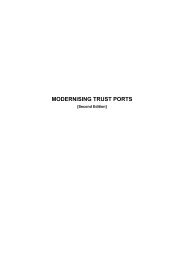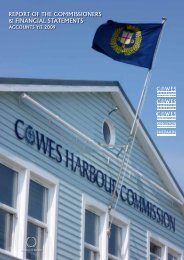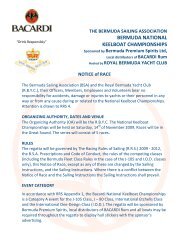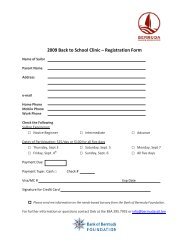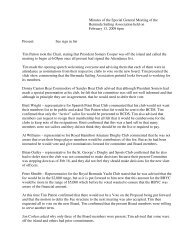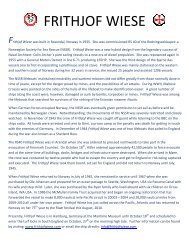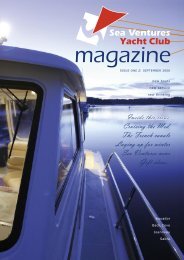local notice to mariners no 11 of 2012 cowes chain ferry
local notice to mariners no 11 of 2012 cowes chain ferry
local notice to mariners no 11 of 2012 cowes chain ferry
Create successful ePaper yourself
Turn your PDF publications into a flip-book with our unique Google optimized e-Paper software.
LOCAL NOTICE TO MARINERS NO <strong>11</strong> OF <strong>2012</strong><br />
COWES CHAIN FERRY<br />
(This <strong><strong>no</strong>tice</strong> supersedes No13 <strong>of</strong> 20<strong>11</strong> Cowes Chain Ferry, which is hereby cancelled.)<br />
The Cowes Chain Ferry (Cowes Floating Bridge) is situated within Cowes Harbour and in<br />
close proximity <strong>to</strong> the blind bend <strong>of</strong> the River Medina and <strong><strong>no</strong>tice</strong> is hereby given that all<br />
<strong>mariners</strong> should navigate with caution in the area <strong>of</strong> the <strong>chain</strong> <strong>ferry</strong>; taking full account <strong>of</strong> the<br />
following points:<br />
1. Nothing in this <strong><strong>no</strong>tice</strong> shall exonerate the <strong>chain</strong> <strong>ferry</strong> from its obligation <strong>to</strong> give way<br />
<strong>to</strong> all traffic under Cowes Harbour Commission Byelaw 34<br />
2. The Chain Ferry operates between the east and west bank <strong>of</strong> the river by hauling on<br />
two <strong>chain</strong>s, each <strong>of</strong> approximately 165 metres, which span across the estuary and are<br />
permanently attached <strong>to</strong> both river banks. These two <strong>chain</strong>s therefore lay partially on<br />
the seabed and part hang in the water in catenaries from slipway <strong>to</strong> slipway.<br />
3. The Chain Ferry operates throughout the year but ceases daily operation across the<br />
river at approximately midnight or shortly thereafter. The service usually resumes<br />
again at approximately 0500 hours Monday <strong>to</strong> Saturday and approximately 0630<br />
hours on Sundays. The service is extended by special arrangement e.g. Cowes Week<br />
4. During the period <strong>of</strong> night when the Chain Ferry is <strong>no</strong>t in operation, the Chain Ferry<br />
may 'moor up' just <strong>of</strong>f the western bank i.e. <strong>no</strong>t in contact with the slipway, <strong>to</strong> prevent<br />
the Chain Ferry remaining stranded or aground in an ebb tide situation. The Chain<br />
Ferry is crewed throughout the 24-hour period and maintains the VHF Channel 69<br />
watch<br />
5. A new hydrographic survey has recently been undertaken, the charts showing the<br />
clearance over the <strong>chain</strong>s at various heights <strong>of</strong> tide (4.3m, 2.4m and 0.5m) and with<br />
the <strong>chain</strong> <strong>ferry</strong> moored at either riverbank. It can be downloaded from the port<br />
website and should be considered when planning your passage.<br />
6. The depth <strong>of</strong> navigable water above these <strong>chain</strong>s varies depending on the state <strong>of</strong> the<br />
tide height and the position <strong>of</strong> the Chain Ferry in relation <strong>to</strong> either east or west<br />
riverbank. The depth <strong>of</strong> navigable water is deepest in the middle <strong>of</strong> the visible<br />
fairway and decreases <strong>to</strong>wards either riverbank and the prow or 'forward end' <strong>of</strong> the<br />
<strong>ferry</strong> as the <strong>chain</strong>s rise closer <strong>to</strong> the surface.
7. When the Chain Ferry is berthed on either riverbank and therefore <strong>no</strong>t partway across<br />
the fairway, the least depth <strong>of</strong> navigable water over the <strong>chain</strong>s is approximately 1.7<br />
metres BELOW chart datum in the middle <strong>of</strong> the visible fairway during the half tide<br />
period.<br />
8. The shallowest section <strong>of</strong> the river lies <strong>to</strong> the south <strong>of</strong> the <strong>chain</strong> <strong>ferry</strong> between the<br />
<strong>no</strong>rthern Whitegates pon<strong>to</strong>ons in the vicinity <strong>of</strong> GKN and Medina Yard where the<br />
depth <strong>of</strong> water is a minimum <strong>of</strong> 1.7m below chart datum at all states <strong>of</strong> tide.<br />
9. All vessels and in particular deep draught sailing vessels shall consider the available<br />
depth <strong>of</strong> water as well as the restrictions and risks associated with the <strong>chain</strong> <strong>ferry</strong><br />
when planning their in port passage plan.<br />
10. Vessels subject <strong>to</strong> the Cowes Pilotage Directions shall be restricted as <strong>to</strong> their<br />
maximum permissible draught when transiting the area <strong>of</strong> the Floating Bridge as<br />
follows:<br />
Maximum Permissible Draught = Actual Tide Height + 1.5metres<br />
When within 0.8metres <strong>of</strong> the maximum permissible draught, the floating bridge shall<br />
be instructed <strong>to</strong> wait on the *EAST bank for the transit <strong>of</strong> the vessel.<br />
*Due <strong>to</strong> the catenary <strong>of</strong> the <strong>chain</strong>s there is an increase in the depth <strong>of</strong> water over the<br />
<strong>chain</strong>s in the middle <strong>of</strong> the visible fairway <strong>of</strong> between 0.3m-1.0m when the <strong>ferry</strong> is<br />
berthed at East Cowes compared with West Cowes.<br />
Other deep draft vessels should also consider using the recommendations in this<br />
clause.<br />
<strong>11</strong>. The Chain Ferry shall by day and night just prior <strong>to</strong> and when proceeding from one<br />
bank <strong>to</strong> the other, exhibit at the fore end a flashing white light so positioned as <strong>to</strong> be<br />
visible all around.<br />
12. Vessels under mechanical propulsion approaching the <strong>chain</strong> <strong>ferry</strong> by reason <strong>of</strong> good<br />
seamanship may reduce their speed if safe and practicable <strong>to</strong> allow the <strong>chain</strong> <strong>ferry</strong> <strong>to</strong><br />
complete her passage <strong>to</strong> the opposite bank, passing astern <strong>of</strong> the <strong>chain</strong> <strong>ferry</strong>.<br />
13. Sailing vessels fitted with mechanical propulsion shall proceed under power when<br />
navigating in any part <strong>of</strong> the Main Harbour Fairway<br />
14. Masters <strong>of</strong> all vessels over 20 metres length, vessels constrained by their draught,<br />
vessels <strong>to</strong>wing and vessels with limited ma<strong>no</strong>euvrability shall call the 'Cowes Chain<br />
Ferry' on VHF radio Channel 69 <strong>to</strong> give indication <strong>of</strong> their approach. Cowes Chain<br />
Ferry opera<strong>to</strong>rs shall ack<strong>no</strong>wledge all such calls. In addition <strong>to</strong> this VHF call the<br />
above vessels shall also sound one prolonged blast when approaching the <strong>chain</strong> <strong>ferry</strong>.<br />
15. Vessels over 20m who require an unimpeded passage but have been unable <strong>to</strong> make<br />
positive VHF contact with the <strong>chain</strong> <strong>ferry</strong> at the usual calling point, shall reduce their<br />
speed <strong>to</strong> the minimum <strong>to</strong> maintain a safe course and be prepared <strong>to</strong> s<strong>to</strong>p if practicable.<br />
16. All vessels navigating within the river shall keep well clear <strong>of</strong> the prow or 'forward '<br />
ramp <strong>of</strong> the Chain Ferry and be aware that if the Chain Ferry is <strong>no</strong>t on either
iverbank and is therefore part way across the fairway, the navigable depth <strong>of</strong> water<br />
above the <strong>chain</strong>s decreases rapidly.<br />
17. During all tides, especially spring tides, there are strong tide currents associated with<br />
this area. The ebb flows are usually more pro<strong>no</strong>unced than the flood. The ebb tide is<br />
accentuated <strong>to</strong>wards the eastern side <strong>of</strong> the river where the spring ebb may be in<br />
excess <strong>of</strong> 4 k<strong>no</strong>ts and cause the unwary <strong>to</strong> be set down upon the eastern bank<br />
especially in the area <strong>of</strong> the Trinity House Wharf (East Cowes) and the Red Funnel<br />
<strong>ferry</strong> terminal (East Cowes)<br />
18. All vessels navigating in these above mentioned areas must adhere strictly <strong>to</strong> the<br />
direction <strong>of</strong> Rule 9 <strong>of</strong> the Merchant Shipping (Distress Signals and Prevention <strong>of</strong><br />
Collisions) Regulations (as amended) which refer specifically <strong>to</strong> the navigation within<br />
narrow channels and areas <strong>of</strong> limited visibility due <strong>to</strong> the bend <strong>of</strong> the fairway and<br />
narrow channel<br />
19. The Chain Ferry maintains a listening watch on the Cowes Harbour Working Channel<br />
(VHF Channel 69) and may give her intentions if so requested on the radio<br />
Captain S McIn<strong>to</strong>sh<br />
Harbour Master, Harbour Office, Town Quay, Cowes, Isle <strong>of</strong> Wight, PO31 7AS<br />
Email: chc@<strong>cowes</strong>.co.uk<br />
Internet: www.<strong>cowes</strong>harbourcommission.co.uk<br />
26 th March <strong>2012</strong>



